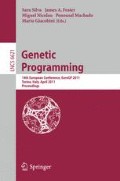Abstract
We investigate the application of adaptive operator selection rates to Genetic Programming. Results confirm those from other areas of evolutionary algorithms: adaptive rate selection out-performs non-adaptive methods, and among adaptive methods, adaptive pursuit out-performs probability matching. Adaptive pursuit combined with a reward policy that rewards the overall fitness change in the elite worked best of the strategies tested, though not uniformly on all problems.
Access this chapter
Tax calculation will be finalised at checkout
Purchases are for personal use only
Preview
Unable to display preview. Download preview PDF.
References
De Jong, K.: Parameter setting in EAs: a 30 year perspective. In: Lobo, F.G., Lima, C.F., Michalewicz, Z. (eds.) Parameter Setting in Evolutionary Algorithms. SCI, vol. 54, pp. 1–18. Springer, Heidelberg (2007)
Schwefel, H.: Numerical optimization of computer models. John Wiley & Sons, Inc., New York (1981)
Thierens, D.: An adaptive pursuit strategy for allocating operator probabilities. In: Proceedings of the 7th Genetic and Evolutionary Computation Conference, pp. 1539–1546 (2005)
Lobo, F., Lima, C., Michalewicz, Z.: Parameter setting in evolutionary algorithms. Springer Publishing Company, Incorporated, Heidelberg (2007)
Fialho, Á., Da Costa, L., Schoenauer, M., Sebag, M.: Dynamic multi-armed bandits and extreme value-based rewards for adaptive operator selection in evolutionary algorithms. In: Stützle, T. (ed.) LION 3. LNCS, vol. 5851, pp. 176–190. Springer, Heidelberg (2009)
Thierens, D.: Adaptive strategies for operator allocation. Parameter Setting in Evolutionary Algorithms, 77–90 (2007)
Goldberg, D.: Probability matching, the magnitude of reinforcement, and classifier system bidding. Machine Learning 5(4), 407–425 (1990)
Tuson, A., Ross, P.: Adapting operator settings in genetic algorithms. Evolutionary Computation 6(2), 161–184 (1998)
Igel, C., Kreutz, M.: Operator adaptation in evolutionary computation and its application to structure optimization of neural networks. Neurocomputing 55, 347–361 (2003)
Thathachar, M., Sastry, P.: A class of rapidly converging algorithms for learning automata. IEEE Transactions on Systems, Man and Cybernetics 15, 168–175 (1985)
Joshi, A.K., Levy, L.S., Takahashi, M.: Tree adjunct grammars. Journal of Computer and System Sciences 10(1), 136–163 (1975)
Hoai, N.X., McKay, R.I., Essam, D.: Some experimental results with tree adjunct grammar guided genetic programming. In: Foster, J.A., Lutton, E., Miller, J., Ryan, C., Tettamanzi, A.G.B. (eds.) EuroGP 2002. LNCS, vol. 2278, pp. 228–237. Springer, Heidelberg (2002)
Hoai, N.X., McKay, R.I.B., Essam, D.: Representation and structural difficulty in genetic programming. IEEE Transactions on Evolutionary Computation 10(2), 157–166 (2006)
Murphy, E., O’Neill, M., Galván-López, E., Brabazon, A.: Tree-adjunct grammatical evolution. In: 2010 IEEE Congress on Evolutionary Computation (CEC), July 1-8 (2010)
Koza, J.R.: Genetic Programming: On the Programming of Computers by Means of Natural Selection. MIT Press, Cambridge (1992)
Fialho, Á., Da Costa, L., Schoenauer, M., Sebag, M.: Extreme value based adaptive operator selection. In: Rudolph, G., Jansen, T., Lucas, S., Poloni, C., Beume, N. (eds.) PPSN 2008. LNCS, vol. 5199, pp. 175–184. Springer, Heidelberg (2008)
Author information
Authors and Affiliations
Editor information
Editors and Affiliations
Rights and permissions
Copyright information
© 2011 Springer-Verlag Berlin Heidelberg
About this paper
Cite this paper
Kim, M.H., McKay, R.I.(., Hoai, N.X., Kim, K. (2011). Operator Self-adaptation in Genetic Programming. In: Silva, S., Foster, J.A., Nicolau, M., Machado, P., Giacobini, M. (eds) Genetic Programming. EuroGP 2011. Lecture Notes in Computer Science, vol 6621. Springer, Berlin, Heidelberg. https://doi.org/10.1007/978-3-642-20407-4_19
Download citation
DOI: https://doi.org/10.1007/978-3-642-20407-4_19
Publisher Name: Springer, Berlin, Heidelberg
Print ISBN: 978-3-642-20406-7
Online ISBN: 978-3-642-20407-4
eBook Packages: Computer ScienceComputer Science (R0)

